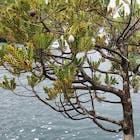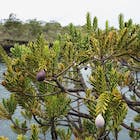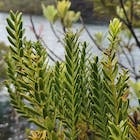
Trees in their native aquatic habitat [Adam Black, 2020.02.01, Facebook post].

Trees in their native aquatic habitat iNaturalist observation 38142663 [Joey Santore, 2020.01.31]

Trees in their native aquatic habitat [Adam Black, 2020.02.01, Facebook post].

Foliage and ripening cones on a tree in habitat iNaturalist observation 38142663 [Joey Santore, 2020.01.31]

Ripening cones on a tree in habitat [Adam Black, 2020.02.01, Facebook post].

Ripening cones on a tree in habitat [Adam Black, 2020.02.01, Facebook post].

Foliage and ripe cones on a tree in habitat iNaturalist observation 38142663 [Joey Santore, 2020.01.31]

Mature foliage [Adam Black, 2020.02.01, Facebook post].

Video on New Caledonia vegetation; R. minus, growing at the Chutes de Madeline, is featured between 04:05 and 12:00 [Crime Pays But Botany Doesn't 2020.02.02].

Conservation Status

Retrophyllum minus
(Carrière) Page 1989
Common names
Bois bouchon (de Laubenfels 1972).
Taxonomic notes
Syn: Nageia minor Carrière 1867; Podocarpus minor (Carr.) Parl. 1868; Podocarpus palustris Buchholz 1949; Decussocarpus minor (Carr.) de Laub. 1969 (de Laubenfels 1972, Farjon 1998); also Retrophyllum minor (orth.).
Holotype : Vieillard 1275, pro parte (Lac Arnaud) (P) (de Laubenfels 1972).
Description
Small tree or shrub, 2-3 m tall. Bark rough, fissured, fibrous, slightly scaly, exfoliating in short and thick verticals bands or in crumpled pieces, light to deep brown, often colored by iron oxide due to periods of immersion. Leafy branchlets opposite or alternate on leafless branchlets, either isolated or in groups at the distal end of an old leafy branchlet, axils having one or two pairs of spreading scales. Juvenile leaves distichous, equally twisted at the base, not close, lanceolate, the distinct midrib with a large raised surface that on the lower side appears to form three ridges, reaching length of 39×3-4.5 mm, very small on old plants, often close between them, not distichous but always equally twisted. Adult leaves almost imbricate and closely spaced, but some have a slight and regular rotation; coriaceous, the distinct midrib having a large raised surface, much larger than the edges which are not raised, oval, dull, 7-20×2.5-5 mm. Leafless scaly branchlets scattered, spreading, roundish, thick, 1.5-2.5 mm long, much smaller on juvenile specimens. Pollen cone solitary, sometimes in groups of five or more, terminal on a deciduous shoot, oval, 4-8×2-2.5 mm. Microsporophyll triangular with a long apex. Seed cone terminal on a leafy branch, formed by 2-3 pairs of decussate squagiform bracts close between them, followed by 2 unequal bracts of which one is fertile (or seldom 2 fertile equal ones). Micropyle of the ovule inverted, situated on the tip of a dull beak that extends 2 mm below the fertile bract; the fertile scale completely encloses the ovule and forms an apical, asymmetric ridge that persists on the ripe fruit. Seed globular or pear-shaped, about 20 mm long with a curved beak, 11-12.5 mm in diameter, covered by fleshy, glaucous scales that sometimes become deep red at maturity. Seed surface rough and porous, well adapted to floating (de Laubenfels 1972). See García Esteban et al. (2004) for a detailed characterization of the wood anatomy.
The base of the trunk is bulging like the trunks of Taxodium species. It differs from its congener R. comptonii in the morphology of the flowers, the male cone and the seed (de Laubenfels 1972).
Distribution and Ecology
New Caledonia. Occurs in the southern part of the island on ultramafic soils (Schmid 1981). It is found only on the Plaine des Lacs, chiefly in the high basin of the river Yaté at elevations of up to 200 m above sea level. The majority of herbarium collections have been from the Rivière des Lacs. It is a rheophyte, a water-dependent plant inhabiting riparian habitats, in this case lakes and the riverbanks in shallow water. Its endangered status, determined in 1998, is based on its very restricted distribution, widespread habitat loss associated with mining, disturbance risks associated with mining and variation in water levels, and an inadequate level of protection within the Chûte de la Madeline Reserve (de Laubenfels 1972, Jaffré et al. 1998).
This map shows herbarium records of Retrophyllum species native to New Caledonia. Red is R. comptonii, and blue is R. minus. Click on an icon for further information. Distribution data from GBIF (2020.03.30), edited to remove duplicates.
The IUCN reports that this taxon is endangered and is facing a very high risk of extinction in the wild. Its range is very limited and is severely framented, the plants surviving at no more than five locations. They are suffering ongoing decline in both the number of plants and the extent/quality of habitat. The total population size has fallen to no more than 2500 mature plants with no subpopulation estimated to contain more than 250 mature plants, and a continuing decline is forecast.
Zone 10 (cold hardiness limit between -1°C and +4.4°C) (Bannister and Neuner 2001).
Remarkable Specimens
No data as of 2023.02.22.
Ethnobotany
No data as of 2023.02.22.
Observations
Farjon (2008) recommends it at the Reserve Botanique de la Chûte de la Madeline (22.233°S, 188.856°E).
Remarks
The epithet minus recognizes that this is quite a small tree, the smallest in the genus.
Citations
Jaffré, T., P. Bouchet and J.-M. Veillon. 1998. Threatened plants of New Caledonia: Is the system of protected areas adequate? Biodiversity and Conservation 7(1): 36.
See also
Association Endemia, a site devoted to New Caledonian species. Has excellent photos, a range map, and other information. In French.
Jaffré, T. et al. 1998. Retrophyllum minor. In: IUCN 2006. 2006 IUCN Red List of Threatened Species. www.iucnredlist.org. Accessed 2007.05.27.
Mill (2016), a very comprehensive monograph of Retrophyllum.
Schmid (1981).








